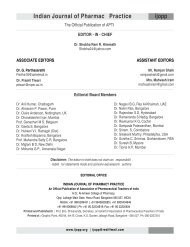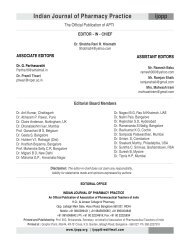APTI ijopp - Indian Journal of Pharmacy Practice
APTI ijopp - Indian Journal of Pharmacy Practice
APTI ijopp - Indian Journal of Pharmacy Practice
- No tags were found...
Create successful ePaper yourself
Turn your PDF publications into a flip-book with our unique Google optimized e-Paper software.
<strong>APTI</strong><strong>Indian</strong> J. Pharm. Pract. 1(2), Jan-Mar, 2009Clinical pharmacy practice in psychiatryChristopher P AldermanDirector, <strong>Pharmacy</strong> Department and Clinical Pharmacist (Psychiatry)Repatriation General Hospital, Daw Park, SOUTH AUSTRALIAAddress for Correspondence: chris.alderman@rgh.sa.gov.auInvited Article<strong>ijopp</strong>An evolution <strong>of</strong> pharmacy practicepatients. The movement to 're-pr<strong>of</strong>essionalisation' <strong>of</strong>In an evolutionary process that has spanned several pharmacy involved practitioners accepting1decades, many pharmacists in primary and secondary responsibility and accountability for their input into thecare settings have shifted their focus from medication patient care process. 8supply functions (largely in the form <strong>of</strong> compounding A concept that is gaining increasing currency andand dispensing) to assisting other clinical staff with the credibility in relation to the role <strong>of</strong> clinical pharmacists inmanagement <strong>of</strong> patients and their drug therapy. This promoting optimal outcomes for patients is theclinical pharmacy practice began in the 1960s, when contribution <strong>of</strong> these practitioners in the facilitation <strong>of</strong>9hospital pharmacists began visiting the wards <strong>of</strong> quality use <strong>of</strong> medicines (QUM). QUM has been definedhospitals to check drug charts and proactively initiate as exhibiting three key componentsmedication supply without the need for prescriptions to judicious selection <strong>of</strong> therapeutic management options2,3be sent to the pharmacy. This practice allowed(considering the place <strong>of</strong> medicines in treating illnesspharmacists to establish a presence at the point <strong>of</strong> patientand maintaining health, and recognising the possibilitycare, in daily contact with doctors and nurses, andthat there may be better ways than medicine to managea particular situation)position themselves to <strong>of</strong>fer advice and assistance withselection <strong>of</strong> a suitable medication, if a medicine is3, 4matters relating to drug therapy.considered necessary. This will involve considerationIn the context <strong>of</strong> ward pharmacy, pharmacists soon<strong>of</strong> the characteristics <strong>of</strong> the individual patient, thebecame involved in roles that included activities such as5clinical condition, risks and benefits associated withrecording patients' medication history and thetreatment options, the dosage and duration <strong>of</strong>qualitative review <strong>of</strong> orders on patients' medicationtreatment, co-existing conditions, other therapies,6charts. These practitioners were starting to assume a rolemonitoring considerations, and costs for thethat helped to guide and inform prescribing, allowingindividual, the community and the health system as a7them to function as a part <strong>of</strong> a multidisciplinary team. whole.Although the re-engineering <strong>of</strong> pharmacy practice to a safe and effective use <strong>of</strong> medications toward-based model facilitated these changes, other achieve optimal health outcomes through monitoring,drivers also contributed. Rationing <strong>of</strong> public health funds minimizing misuse, over-use and under-use <strong>of</strong> medicreatedchanges for the hospital sector, so that only the cations, and ensuring that the patient or their carer havemost acutely ill patients were admitted to hospital, for the knowledge and skills to solve problems related toexample. This in turn meant that the acuity and the use <strong>of</strong> their medication(s).complexity <strong>of</strong> inpatient care progressively increased. The QUM framework extends the pharmaceutical careAdvances in pharmacotherapy led to the discovery and model and provides a mechanism for integrating clinicalwidespread implementation <strong>of</strong> entirely new drug pharmacists into the broader health care environment.treatment approaches for many clinical problems,It has the potential to address the issues that the morepr<strong>of</strong>ession-specific pharmaceutical care model raisedcreating a rapid expansion in the scope <strong>of</strong> informationin terms <strong>of</strong> the integration <strong>of</strong> pharmacists into theabout the clinical applications for these drugs, theirhealthcare team. It also facilitates the routineadverse effects and drug interactions and the need forincorporation <strong>of</strong> pharmaceutical care as a component <strong>of</strong>individualisation <strong>of</strong> dosage to accommodate the needs <strong>of</strong>emerging service delivery programs in hospitals, agedcareand primary health care settings and health care<strong>Indian</strong> <strong>Journal</strong> <strong>of</strong> <strong>Pharmacy</strong> <strong>Practice</strong>teams. It is important, therefore, that the uniqueReceived on 12/03/2009Accepted on 12/03/2009 © <strong>APTI</strong> All rights reservedcontribution <strong>of</strong> clinical pharmacists that results from the1
















